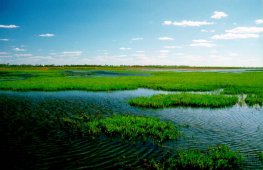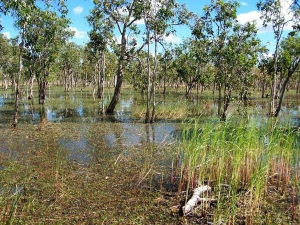|
|
Wetland flora (plants)The prolonged presence of water creates conditions that favour the growth of specially adapted plants (hydrophytes). There is also a strong relationship between soil saturation and the development of communities dominated by plants specifically adapted to, and requiring, such conditions. Using plants (or soils) that are adapted to and dependent on wet conditions means that the definition of wetlands includes lands where inundation with water is the dominant factor determining the nature of soil development or the types of plants living in the soil and on its surface[1]. Quick links
You can use the WetlandSummary or WetlandMaps tools to find out what wetland species are found in your area. For a full list of available wetland indicator species use the list of hydrophytes.
Wetland plant functionsPrimary production is the rate at which plants covert carbon dioxide and water into energy-rich carbon compounds[5]. This production of organic matter is what contributes to plant biomass. Wetlands are among the most productive ecosystems on the planet, supporting dense forests, and abundant populations of aquatic species. Productivity is also influenced by temperature, water availability and quality, and light. Gross primary production (GPP) is the conversion of light energy and water into biochemical fixation of carbon dioxide, which is produced largely by plants. Some of this is lost through respriration and other plant functions (such as nutrient uptake from soil and fixation of atmospheric nitrogen). The remaining GPP is termed Net primary production (NPP) and is the resulting biomass produced from GPP[2][9]. Wetland plants as a wetland attribute
Wetland plants—also known as hydrophytes—are defined as plants ‘that grow in water or need a waterlogged environment’. Therefore hydrophytes have long been used as indicators of wetlands both in Australia[3][4] and overseas[4]. This definition is equivalent to plants described in the Queensland Wetlands Program definition as: ‘…plants …that are adapted to and dependent on living in wet conditions for at least part of their life cycle…’. Therefore the term hydrophytes is used as a convenient abbreviation for plants described by that attribute. Hydrophytic adaptations may be morphological (e.g. shallow roots to facilitate survival during times of waterlogging), reproductive (e.g. seeds need a certain amount of flooding to germinate, they can germinate in water or are dispersed by flooding) or physiological (e.g. plants can be tolerant to toxins created by anaerobic conditions). Many non-hydrophytes cannot grow where there is even minor waterlogging. Adaptations of hydrophytes may allow plants to establish and effectively eliminate competition from plants less adapted to wet conditions. Compilation of a wetland plant indicator list
A list of hydrophytes has been assembled to supplement the Queensland wetland definition and help identify wetlands. Generally, the list is restricted to higher plants and does not comprehensively include lower plants, such as algae and fungi, due to the small amount of knowledge of these latter groups. Plant names follow those listed in the Census of the Queensland Flora 2010[1] or subsequent versions of that list. Plant species are included in the list if they are only recorded to occur naturally, achieve maturity and successfully reproduce in areas that experience wet conditions. Wet conditions are defined as areas where the root zone becomes periodically saturated or inundated during the growing season. These are similar criteria to those listed to assess hydrophytes in America[6]. Such plants are assessed, by association with such environments, to meet the criteria that they are adapted to and dependent on wet conditions for at least part of their life cycle. It is expected that this list will be updated as more information is reviewed or becomes available through applying the definition in field assessments as well as through botanical research. At a species level plants do not have uniform environmental requirements for growth and reproduction[8], and individual populations of plants may differ in their adaptation to waterlogging or flooding[7]. Thus future updates to this list may include subsets of species such as species in a particular region that are considered hydrophytes. Additional information
Pages under this sectionReferences
Last updated: 6 August 2021 This page should be cited as: Department of Environment, Science and Innovation, Queensland (2021) Wetland flora (plants), WetlandInfo website, accessed 25 June 2024. Available at: https://wetlandinfo.des.qld.gov.au/wetlands/ecology/components/biota/flora/ |

 — Department of Environment, Science and Innovation
— Department of Environment, Science and Innovation




